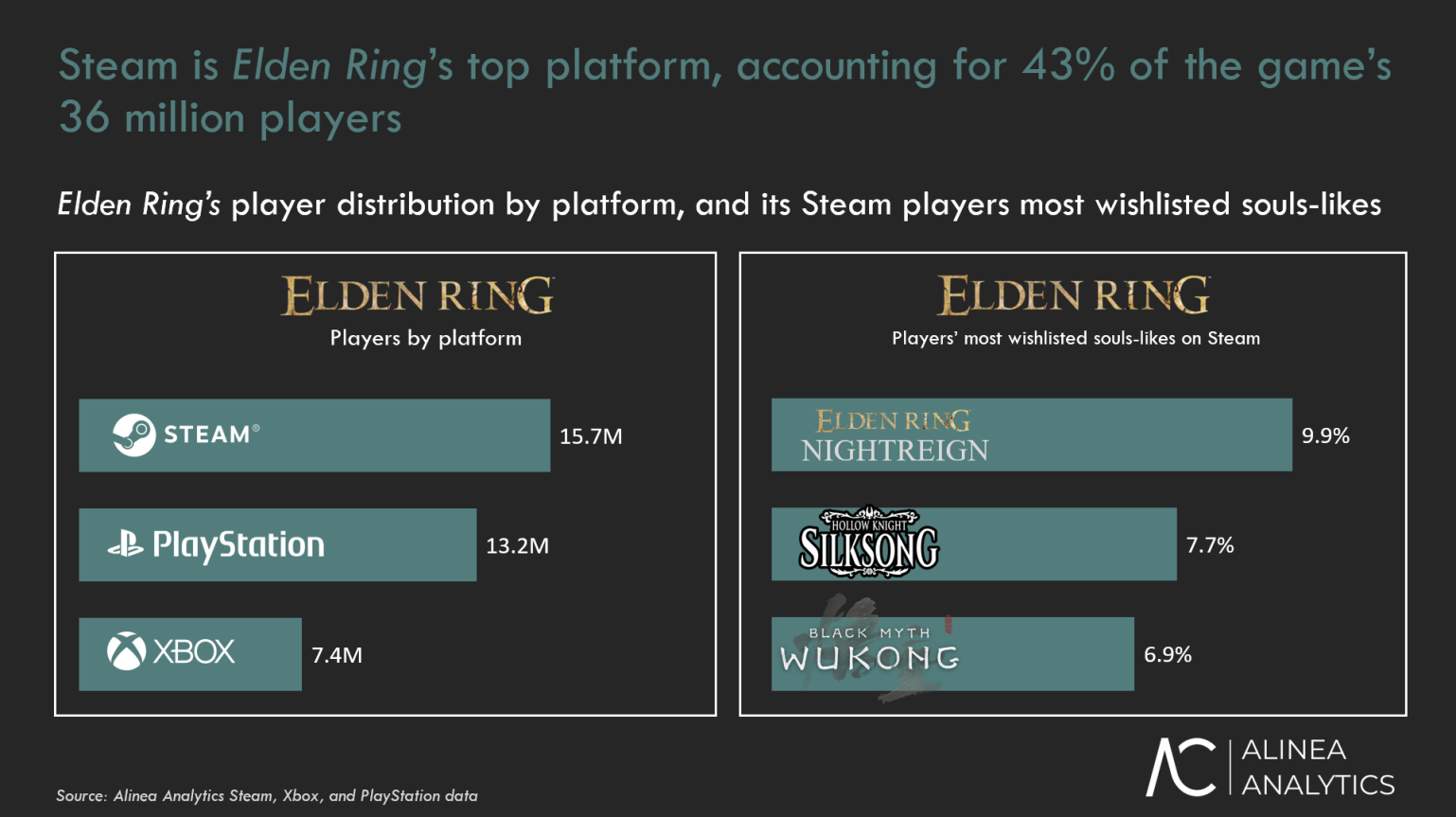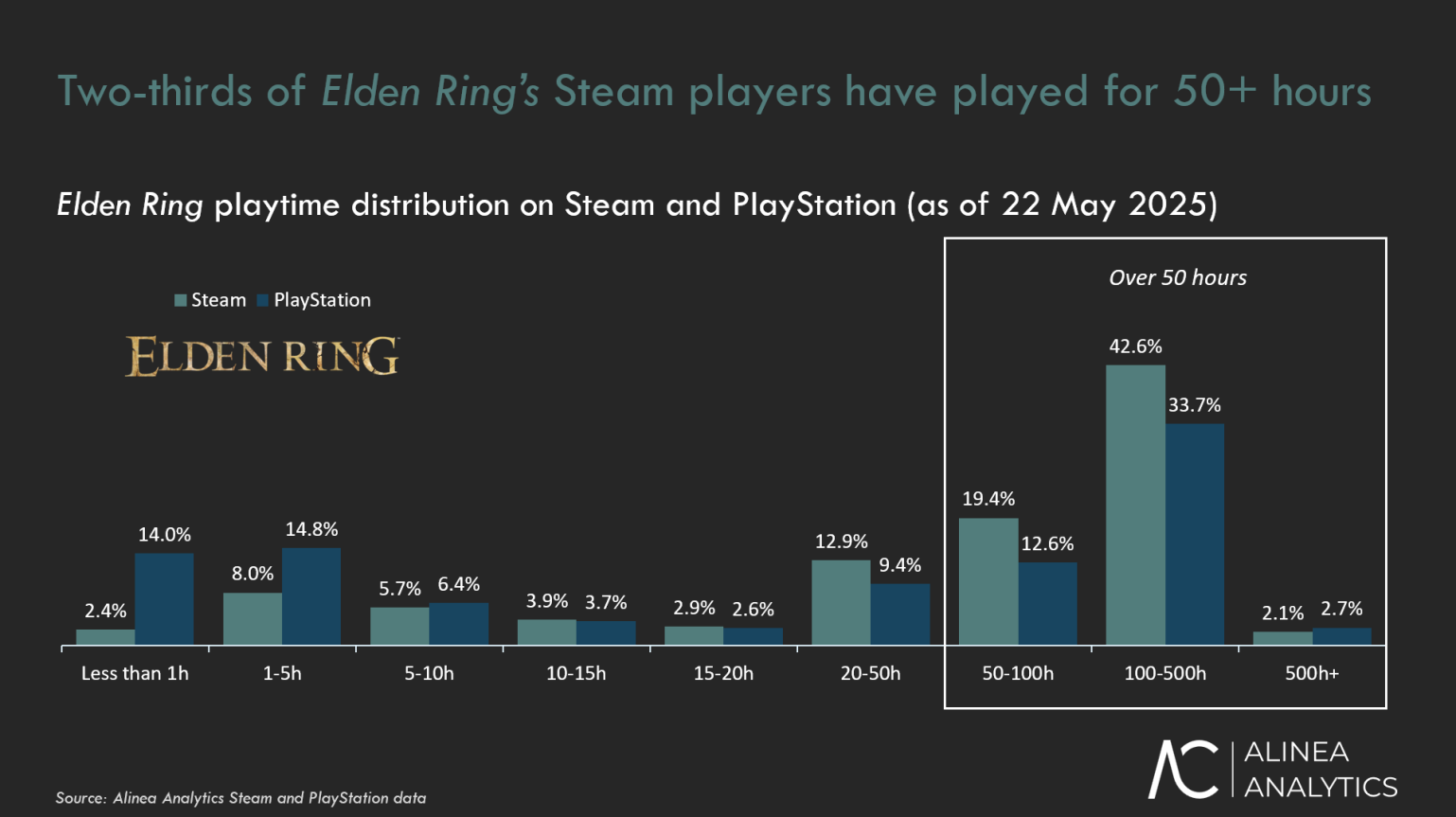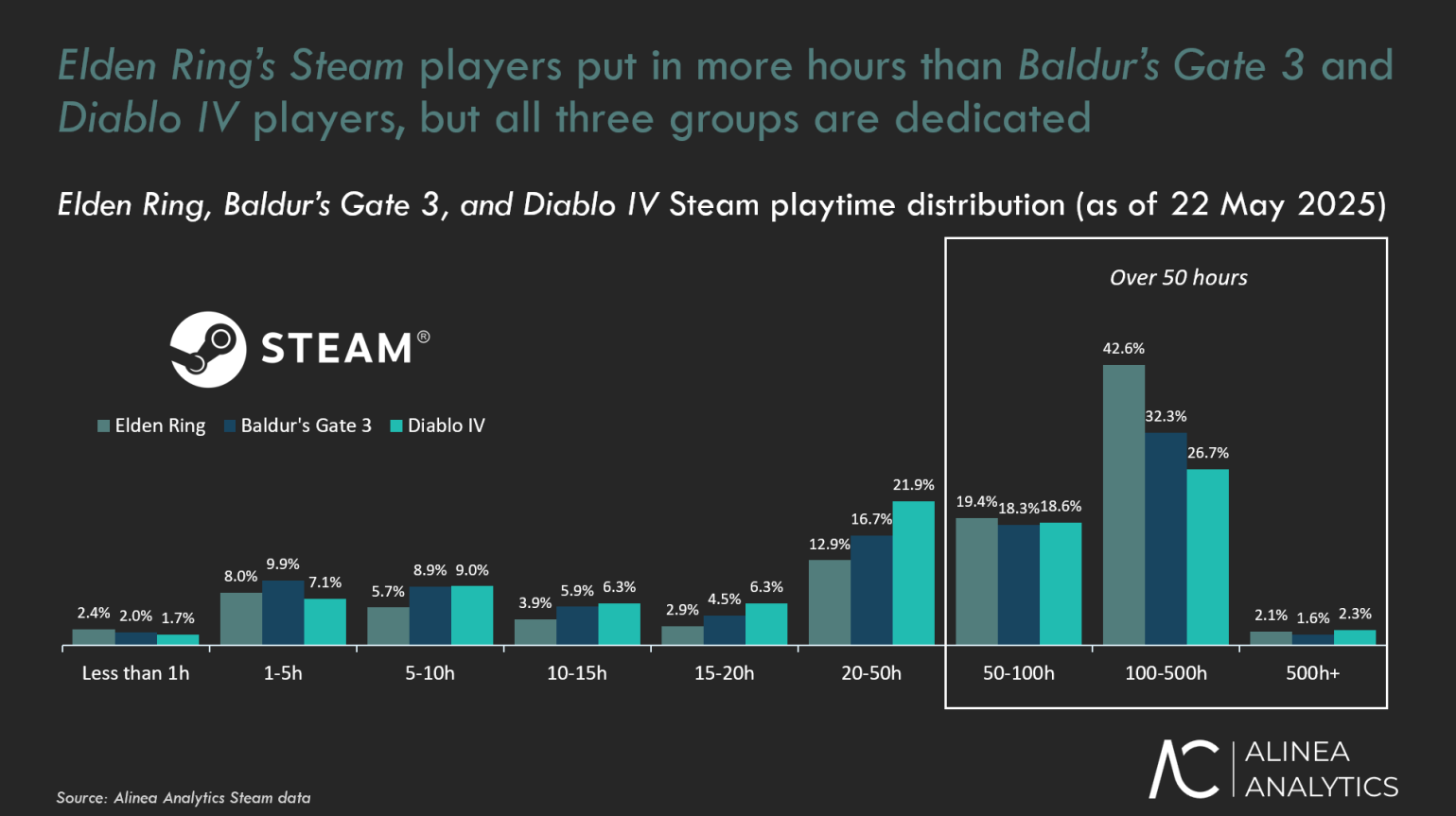by Rhys Elliott
Elden Ring’s player engagement is through the roof: 45% of its Steam players have played for 100+ hours
Elden Ring’s player engagement is through the roof: Over 45% of its Steam players have played for 100+ hours
Elden Ring is one of the most successful premium games of all time. Building on everything FromSoftware laid out with the Dark Souls series and adding it to an open world, Elden Ring true coming-out party for FromSoftware.
It won game of the year at The Game Awards, has one of the highest Metacritic scores of all time, and has sold over 30 million copies as of the last official announcement.
Alinea data shows that Elden Ring has now reached a staggering 36 million players across all platforms, with revenues approaching $2 billion.
Steam accounts for 15.7 million players – 43% of the game’s audience – meaning Steam is Elden Ring’s biggest platform. PlayStation comes in second with 13.2 million, while Xbox accounts for the remaining 7.4 million:

FromSoftware extended Elden Ring’s product lifecycle with a sprawling expansion last June. Alinea data shows that the Shadow of the Erdtree expansion sold 2.4 million copies on Steam alone (an attach rate of 16.3% and revenues of $77 million).
The show isn’t over yet, Tarnished
Next week, FromSoftware is launching Elden Ring Nightreign, a standalone PVE roguelike with a $40 price point.
Almost 10% of Steam’s Elden Ring players have wishlisted Nightreign, which has 2.5 million wishlists overall. Our data also shows that 300K Steam players have already bought Nightreign.
While the jury is still out on the quality of From Software’s first multiplayer-first Soulslike, all these indicators point to Nightreign being a huge success. And there’s also a Switch 2 version of the original Elden Ring en route, providing yet another boost for the franchise.
Want to see how Nightreign performs across Steam and console? Reach out to us, and we’ll give you a trial of our platform.
Elden Ring is an engagement powerhouse that even surpasses engagement-driven live-service games
Elden Ring – and especially its DLC – is hard. While it abandons the linear structure of FromSoftware’s previous games, giving players more choice when they’re stuck, Elden Ring’s bosses are some of the most challenging out there.
I’m looking at you, Malenia and Promised Consort Radahn.
Despite the game’s mercilessness, 10.9% of Elden Ring players on PlayStation and 10.2% on Steam have unlocked every trophy/achievement in the game. However, just 3.7% of Xbox players managed this feat.
The trophy/achievement data clearly shows that Elden Ring players are dedicated – especially on Steam and Xbox. But looking deeper at Alinea’s playtime distribution data reveals just how dedicated they really are:

The results are striking:
- 64% of Elden Ring players on Steam have played for over 50 hours (versus 49% for PlayStation players)
- PlayStation players have triple the share of under-5-hours players, signalling that Elden Ring didn’t click for everyone on the platform – perhaps due to the difficulty
- Seven million Steam players – 44.7% of Elden Ring’s Steam audience – have played for over 100 hours. That share is 36.7% (almost 5 million players for PlayStation)
But perhaps most remarkably of all, almost 700K players across PlayStation (2.7%) and Steam (2.1%) have played Elden Ring for over 500 hours. Talk about dedication!
How does Elden Ring’s playtime distribution compare to other time-sink RPGs?
While Elden Ring’s playtime distribution is impressive, let’s not look at it in a vacuum.
We’ll be looking at our Steam data for Elden Ring (15.7 million Steam players), Baldur’s Gate 3 (14.6 million), and Diablo IV (1.5 million). As you can see, there are some distinct player engagement patterns:

All three games are engagement powerhouses. The attention economy is oversaturated, but gamers will make time for quality titles. Case in point: The highest distribution category for each game – by a significant margin – is the 100-500 hour group:
- Elden Ring leads overwhelmingly at 42.6% in 100-500h, a testament to its vast open world, build diversity, and replayability via New Game+ modes
- Baldur’s Gate 3’s 32.3% in the 100-500h bracket underlines its replayability, driven by permutations in narrative choices, romances, and endings
- Diablo IV, while lagging slightly (26.7%), still sees a dedicated cohort, likely sustained by seasonal updates
Of the three games, Diablo IV has the highest share of players in the 10-15h, 15-20h and, 20-50h groups. This suggests that many players are seeing the game’s story through, but aren’t necessarily playing the endgame content and grind loop.
That said, Diablo IV leads in the 500h+ tier (2.3%), suggesting a niche of hardcore grinders. Elden Ring and BG3 – despite their depth – cater more to completists than perpetual players.
Elden Ring was marketed heavily and received incredibly high review scores, but it’s clearly not for everyone. Elden Ring has the highest share of players who played for under an hour. Its notorious difficulty curve likely filtered out casual players early.
These splits reflect each title’s core identity: Elden Ring as a repayable challenge, BG3 as a narrative odyssey, and Diablo IV as a cyclical grind.
The attention economy is oversaturated, and we at Alinea have long been advocates of indies and shorter, more sustainable games like Clair Obscur: Expedition 33 and Astro Bot.
But there’s still a player appetite for big-budget 100-hour games, and gamers are happy to make time for these experiences if they resonate.